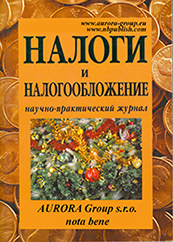Question at hand
Reference:
Savina, O.N. (2017). Tax Benefits Inventory as an Evaluation of Tax Efficiency. Taxes and Taxation, 4, 1–19. https://doi.org/10.7256/2454-065X.2017.4.20189
Abstract:
The article is devoted to developing tools that enhance the assessment of efficiency of tax credits and other tax benefits. Issues related to evaluating the impact of tax incentive tools have been relevant throughout the entire period of operation of the Russian taxation system. These issues are becoming especially acute during the period of political and economic instability when there is the need to stimulate production and encourage investment and innovation activity in the country. The existing tools of tax incentives in the tax system of the Russian Federation differ in big variety of forms and types, but their impact is not fully and duly applied. To improve the quality of tax benefits and other tax advantages inventory as the initial stage of tax efficiency evaluation should be closely studied. The author gives examples of describing tax benefits for the purposes of their inventory, which in turn allows to organize all tax advantages on classification grounds highlighting their similarities and differences as well as to develop common approaches to the development of criteria and indicators evaluating their effectiveness. Efficiency criteria described herein are supplemented with calculated indices which can be further completed by certain tax benefits, their types, etc. instruments, groups of taxes, categories of taxpayers, branches, activities and other indicators depending on the objectives of the study. Using the above figures the author makes decisions regarding the selection of effective tax concessions in order to create an optimal system of tax incentives and other advantages which should be understood as the total of tax incentives and other advantages that meets the fundamental principles of preferential taxation and allows the most efficient implementation of fiscal and regulatory functions of taxation. In conclusion the author emphasizes the need to continue to improve the aforesaid model. According to the author, it is impossible to carry out a qualitative evaluation of tax efficiency without the engagement of additional approaches (to estimate the weights of the factors influencing indicators). It is assumed that tax incentives efficiency evaluation may be used for more research: for example, performance audit, interviews, and expert assessment.
Keywords:
tax tools, tax benefits, tax preferences, ordering, inventory, performance, of the methods of evaluating the effectiveness, assessment of the effectiveness, tax incentives, principles of preferential taxation
International Tax Law
Reference:
Kurochkin, D.A. (2017). Issues of Differentiation of Active and Passive Economic Activity Income in Russia in Terms of Cross-Border Taxation. Taxes and Taxation, 4, 20–30. https://doi.org/10.7256/2454-065X.2017.4.22696
Abstract:
The subject of the research is the classification of taxable income based on active economic activity income and passive economic activity income. The author discusses legislative and doctrinal approaches to the subject of the research and covers the cross-border aspect of the taxation of active and passive income. The author of the article pays special attention to criterion of the differentiation of taxable income into active and passive activity income as it is proposed by the Russian legislator, model tax conventions and scientific literature. Kurochkin provides a critical assessment and highlights the advantages and disadvantages of each identified criterion. The author has used formal-logical and comparative legal research methods, historical, literal and systematic interpretation of tax legislation standards and international acts. Based on the research results the author comes to the conclusion about imperfection of the Russian legislative model of division of taxable income into active and passive, which, moreover, is not applicable to all tax relations. The lack of standardized rules and clear criteria for differentiating income into active and passive creates preconditions for double taxation of some income that can be classified as both active and passive. The novelty of the research is caused by the fact that taking into account the identified scientific and practical approaches to the taxation of active and passive income (in the absence of a serious and fundamental researches of this question) the author suggests the most appropriate fo the Russian legislation criteria for differentiating taxable incomes that meet recognized international standards and eliminate the risk of double taxation: the nature of legal facts involving obtaining passive or active activity income by a taxpayer.
Keywords:
international tax treaties, double taxation, cross-border taxation, criterion for differentiating income, passive income, active income, taxable income, tax legislation, taxpayer, tax
PREDICTION AND PLANNING IN TAXATION
Reference:
Giraev , V.K. (2017). The Influence of Taxes on the Profit Generation Mechanism. Taxes and Taxation, 4, 31–50. https://doi.org/10.7256/2454-065X.2017.4.21652
Abstract:
The article is devoted to the influence of corporate tax on the profit generation mechanism. The subject of the research is the role and place of profit tax in the process of encouraging corporate investment activity based on the development strategy selected. The theme of the article involves a brief analysis of investment processes combined with assessing financial results of Russian enterprises' activities. The purpose of the research is to develop and provide grounds for directions to improve taxation of corporate profit to encourage investments, economic growth and budget revenues increase. Using mathematical tools, the author of the article has modelled the investment development strategy of an enterprise highlighting the static and dynamic elements thereof. In his research Giraev has used analysis, synthesis, systems approach, optimisation and other research methods. As a result of his research, Giraev emphasizes the need to develop the separate taxation of investment-oriented profits and consumption-oriented profits. To maintain a sustainable economic growth in Russia under modern conditions, it is necessary to exempt corporate profits appointed at real investments in basic branches and domestic consumption from taxation. According to the author, implementation of the aforesaid approach would increase the volume of corporate profits which will contribute to the sustainable economic growth and continuing increase of budget profits.
Keywords:
tax trap, profit prediction, net profit, profit rate, company statics, profit strategy, investments, profit, profitability, interest income
FEDERAL TAXES AND LEVIES COLLECTED FROM ORGANIZATIONS
Reference:
Bryantseva, L.V., Elovatskaya, T.A., Orobinskii, A.S. (2017). The Main Problems of Selecting an Efficient Taxation System as a Mean of Providing Budget with Revenues. Taxes and Taxation, 4, 51–61. https://doi.org/10.7256/2454-065X.2017.4.22899
Abstract:
The subject of the research is an organised combination of individual elements of the taxation system and relations between them as well as development of Russia's taxation system and the main reasons of its imperfection. The authors of the article pay special attention at an efficient taxation system that implies a high level of profitability and severe reduction of expenses caused by time, money and other expenditures when collecting taxes. The authors analyze goals of improving Russia's taxation system, the main trends of increasing its efficiency and the main problems of the Russian taxation system that need to be solved in order to find an efficient model of taxation. The methodological basis of the research involves the dialectical research method, complex approach, formal logic, historical and logical analysis and synthesis, inductive and deductive research of phenomena, financial calculation and analytical methods, comparison and statistical distribution. The scientific novelty of the research is caused by the need to improve the system and methods of governing the profits of the Russian Federation federal budget under the conditions of a crisis reduction of sources and volumes of budget revenues which increases opportunities of financial support of socially important programs and incompatible with the status of a social state. The authors underline that the core of the taxation system is the mandatory payments of compulsory nature. Different types of taxes are organised differently in different taxation systems. Searching for an efficient taxation system, it is necessary to pay attention at measures that are undertaken by foreign states undergoing a similar crisis situation. For example, EU states and Pacific countries embark on a course of increasing personal income while North American countries increase corporate taxes. As it is noted by the authors, these schemes alone are very unlikely to increase efficiency of the taxation system. It would be more beneficial to use a progressive taxation scheme instead of just increasing taxes. When it comes to business, the taxation systems used in the Middle East may turn out to be in high demand. In conclusion the authors describe the main problems of the Russian taxation system that need to be solved in order to develop an efficient model of taxation.
Keywords:
optimization of taxation, direct taxes, tax incentives, tax reforms, tax burden, tax revenues, tax system, Tax, social justice, electronic document management
THEORY AND HISTORY OF TAXATION
Reference:
Ilyasova, N.F. (2017). Presumptive Income as a Taxable Item in Russia at the End of the 19th Century. Taxes and Taxation, 4, 62–68. https://doi.org/10.7256/2454-065X.2017.4.22920
Abstract:
The subject of the research is the category of presumptive tax as a legal presumption of receiving a certain profit defined by particular exteral indicators defined by the Russian tax law of the late 19th century. In her article Ilyasova explains the need and evaluates the results of including such taxable items as 'presumptive income' and 'average income' into the Russian taxation system. For this purpose the author compares two legislative acts issued in the sphere of trade taxation (1885 and 1898) and analyzes archives describing the process of preparing draft laws in the sphere of taxation at the end of the 19th century. The main research method used by the author is the historical and legal analysis. The author has also used the logical method, methods of comparison and analysis. The author describes two variants of using the category of presumptive income in the tax legislation of the late 19th century. These are: 1) as an individual taxable item; 2) as an indicator of other taxable items. The author concludes that presumptive income is used as an individual taxable item only in trade tax law.
Keywords:
taxable item, legal presumption, distributing levy, average income, presumptive income, net profit, flat tax, income tax, trade tax, Russian Empire
 This work is licensed under a Creative Commons Attribution-NonCommercial 4.0 International License.
This work is licensed under a Creative Commons Attribution-NonCommercial 4.0 International License.
 Eng
Eng












 © 1998 – 2025 Nota Bene. Publishing Technologies. NB-Media Ltd.
© 1998 – 2025 Nota Bene. Publishing Technologies. NB-Media Ltd.




